Claude-Joseph Vernet - Master of Marine and Landscape Paintings
K.J Admin on 12th Jan 2024
Claude-Joseph Vernet was a renowned French painter of the 18th century, celebrated for his captivating maritime landscapes and breathtaking scenes of nature. His artistic vision and technical prowess made him one of the most influential artists of his time.
This article explores the life and works of Claude-Joseph Vernet, divided into sections that shed light on his early childhood, education, professional highlights, artistic style, famous paintings, and lasting contributions to the world of art.

Early Childhood and Education
Claude-Joseph Vernet was born on August 14, 1714, in Avignon, France. He came from a family of artists, with his father Antoine Vernet being a proficient painter. Growing up in an environment steeped in artistic influence, Claude-Joseph developed a deep appreciation for the natural world from an early age. He showed great talent and a passion for painting, prompting his father to provide him with the necessary guidance and support.
At the age of 14, Claude-Joseph Vernet moved to Aix-en-Provence, where he began his formal artistic education. Under the tutelage of his father and other local painters, he honed his skills and gained a solid foundation in the principles of art. During this time, Vernet also studied the works of renowned landscape painters, such as Salvator Rosa and Claude Lorrain, whose influence would later become evident in his own compositions.
Professional Highlights and Influences
In his early twenties, Vernet relocated to Rome, Italy, to further his artistic education. The vibrant art scene and picturesque landscapes of Italy provided him with endless inspiration. During his time in Rome, Vernet studied under the guidance of the Italian landscape painter Bernardino Fergioni. Under Fergioni's mentorship, Vernet refined his techniques and developed a deep understanding of the interplay between light, atmosphere, and natural elements.
Vernet's time in Rome also exposed him to the works of renowned Italian artists, including Canaletto and Giovanni Paolo Panini. These masters greatly influenced Vernet's artistic style, particularly in his ability to capture the intricacies of architectural structures and the play of light on water surfaces.
Artistic Style
Claude-Joseph Vernet is best known for his mastery of the genre known as "maritime landscapes." His paintings depicted coastal scenes, seaports, and storms at sea, often infused with a sense of drama and natural beauty. Vernet's meticulous attention to detail, use of vibrant colors, and skillful rendering of light and atmosphere brought his compositions to life.
One of Vernet's notable contributions to the art world was his ability to convey the power and dynamism of nature. Whether depicting tranquil seascapes or tumultuous storms, his works captured the ever-changing moods of the sea with remarkable precision. Vernet's compositions often featured elements of human activity, such as ships, fishermen, or coastal communities, adding a narrative quality to his landscapes.
Famous Paintings and Later Accolades
Claude-Joseph Vernet's body of work includes numerous masterpieces that have secured his place in art history. Among his most famous paintings is "The Shipwreck" (1772), a gripping scene that showcases his ability to capture the intensity of a maritime disaster. Another renowned work is "The Port of Rochefort" (1763), which depicts a bustling harbor filled with ships, capturing the essence of a vibrant maritime community.
Throughout his career, Vernet received numerous accolades and recognition for his artistic achievements. In 1753, he was appointed a member of the French Royal Academy of Painting and Sculpture, cementing his reputation as one of the leading painters of his time. His works were highly sought after by collectors and patrons, and he received commissions from prominent figures, including King Louis XV of France.
Contribution to the World of Art
Claude-Joseph Vernet's contributions to the world of art extend beyond his individual paintings. He played a significant role in elevating the genre of maritime landscapes to new heights of recognition and popularity. Vernet's ability to capture the grandeur of nature and evoke emotions through his art resonated with audiences across Europe.
Vernet's influence extended to future generations of artists who sought to emulate his style and capture the beauty of the natural world. His works served as an inspiration for Romantic painters, who embraced the sublime and the awe-inspiring aspects of nature in their compositions.
Legacy and Where to View His Paintings
Claude-Joseph Vernet's legacy as a master of maritime landscapes endures to this day. His paintings can be viewed in prestigious museums, art galleries, and institutions around the world. Some notable places to view his works include the Louvre Museum in Paris, France, the Metropolitan Museum of Art in New York City, USA, and the National Gallery in London, UK.
Conclusion
Claude-Joseph Vernet's artistic journey from his early childhood in Avignon to his mastery of maritime landscapes in Rome has left an indelible mark on the world of art. His ability to capture the essence of nature, infuse his compositions with drama, and convey the power of the sea set him apart as a true visionary. Through his enduring works, Vernet will always be remembered as a master painter who brought the beauty of the natural world to life on canvas.
References
- Clark, Anthony M. "Claude-Joseph Vernet." Grove Art Online. Oxford Art Online. Oxford University Press. Accessed July 9, 2023.
- Roland-Michel, Marie. "Claude-Joseph Vernet: Painter of Nature." Yale University Press, 2011.
- "Claude-Joseph Vernet." The Metropolitan Museum of Art. Accessed July 9, 2023. https://www.metmuseum.org/art/collection/search#!?q=Claude-Joseph%20Vernet&perPage=20&sortBy=Relevance&offset=0&pageSize=0.
- "Claude-Joseph Vernet." Louvre Museum. Accessed July 9, 2023. https://www.louvre.fr/en/oeuvre-notices/shipwreck-storm-coast.
- "Claude-Joseph Vernet." National Gallery. Accessed July 9, 2023. https://www.nationalgallery.org.uk/artists/claude-joseph-vernet.






